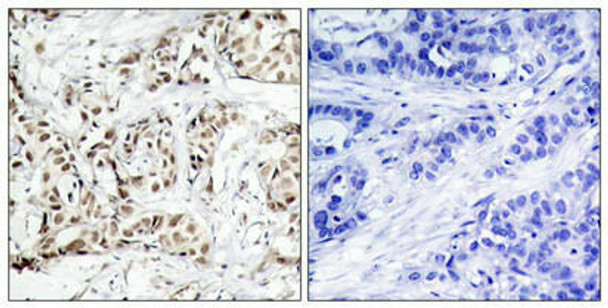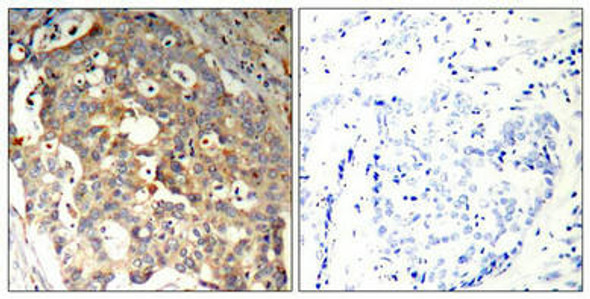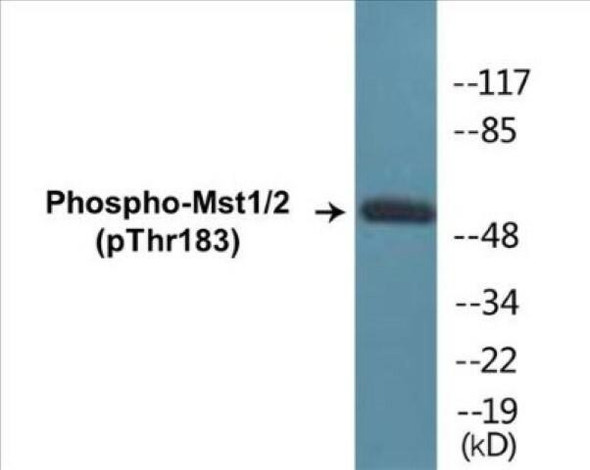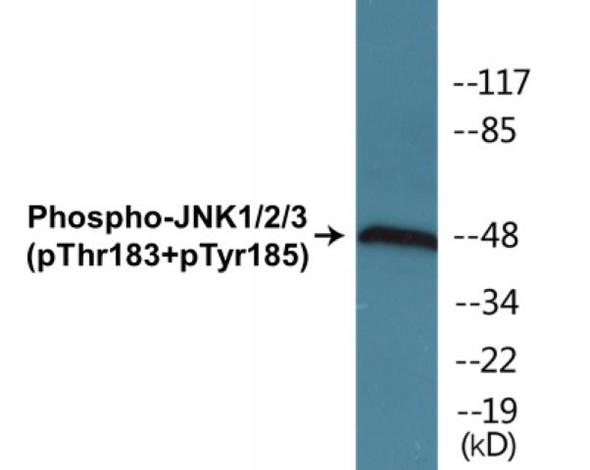Description
Phospho-MAPK9/MAPK10 (Thr183) Antibody (PACO24489)
The Phospho-MAPK9/MAPK10 (Thr183) Antibody (PAC024489) is a valuable tool for researchers studying the MAPK signaling pathway. This antibody, produced in rabbits, specifically targets the phosphorylated form of MAPK9 and MAPK10 at Thr183, allowing for precise detection and analysis in Western blot applications.MAPK9 and MAPK10, also known as JNK1 and JNK2, are members of the mitogen-activated protein kinase (MAPK) family that play important roles in cellular processes such as proliferation, differentiation, and apoptosis. Phosphorylation at Thr183 is a key regulatory event that activates JNK signaling and is involved in various physiological and pathological processes.
The Phospho-MAPK9/MAPK10 (Thr183) Antibody is highly reactive with human samples and offers reliable performance in detecting the phosphorylated forms of JNK1 and JNK2. Its specificity and sensitivity make it an ideal tool for studies in cell signaling, cancer research, and other areas where MAPK signaling is implicated. By understanding the activation and regulation of MAPK9 and MAPK10, researchers can gain insights into the complex mechanisms underlying cell behavior and disease progression.
| Antibody Name: | Phospho-MAPK9/MAPK10 (Thr183) Antibody (PACO24489) |
| Antibody SKU: | PACO24489 |
| Size: | 100ul |
| Host Species: | Rabbit |
| Tested Applications: | ELISA, WB, IHC |
| Recommended Dilutions: | ELISA:1:2000-1:10000, WB:1:500-1:1000, IHC:1:50-1:100 |
| Species Reactivity: | Human, Mouse, Rat |
| Immunogen: | Peptide sequence around phosphorylation site of threonine 183 (M-M-T(p)-P-Y) derived from Human SAPK/JNK. |
| Form: | Liquid |
| Storage Buffer: | Supplied at 1.0mg/mL in phosphate buffered saline (without Mg2+ and Ca2+), pH 7.4, 150mM NaCl, 0.02% sodium azide and 50% glycerol. |
| Purification Method: | Antibodies were produced by immunizing rabbits with synthetic phosphopeptide and KLH conjugates. Antibodies were purified by affinity-chromatography using epitope-specific phosphopeptide. Non-phospho specific antibodies were removed by chromatogramphy using non-phosphopeptide. |
| Clonality: | Polyclonal |
| Isotype: | IgG |
| Conjugate: | Non-conjugated |
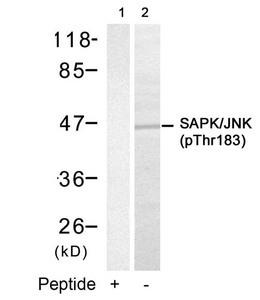 | Western blot analysis of extracts from 293 cells using SAPK/JNK(Phospho-Thr183) Antibody(Lane 2) and the same antibody preincubated with blocking peptide(Lane1). |
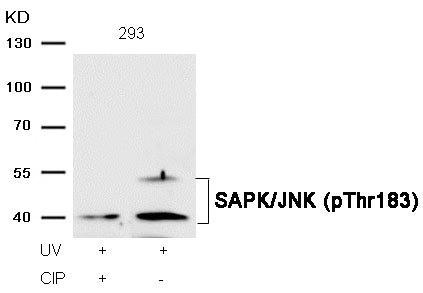 | Western blot analysis of extracts from 293 cells, treated with UV or calf intestinal phosphatase (CIP), using SAPK/JNK (Phospho-Thr183) Antibody. |
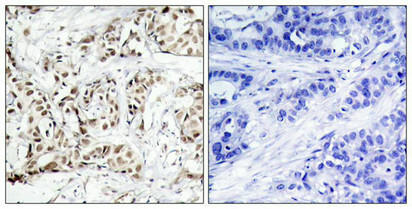 | Immunohistochemical analysis of paraffin-embedded human breast carcinoma tissue using SAPK/JNK(Phospho-Thr183) Antibody(left) or the same antibody preincubated with blocking peptide(right). |
| Background: | Responds to activation by environmental stress and pro-inflammatory cytokines by phosphorylating a number of transcription factors, primarily components of AP-1 such as c-Jun and ATF2 and thus regulates AP-1 transcriptional activity. In T-cells, JNK1 and JNK2 are required for polarized differentiation of T-helper cells into Th1 cells. |
| Synonyms: | JNK2 |
| UniProt Protein Function: | JNK2: a protein kinase of the MAPK family that is potently activated by a variety of environmental stresses including UV radiation. Phosphorylates specific transcription factors such as c-Jun and ATF2, mediating immediate-early gene expression. Closely related to JNK1. Both are involved in UV radiation induced apoptosis. Blocks the ubiquitination of tumor suppressor p53, and thus it increases the stability of p53 in nonstressed cells. JNK1 and JNK2 are required for polarized differentiation of T-helper cells into Th1 cells in the mouse. Four alternatively-spliced isoforms have been described. |
| UniProt Protein Details: | Protein type:Protein kinase, Ser/Thr (non-receptor); EC 2.7.11.24; Protein kinase, CMGC; Kinase, protein; CMGC group; MAPK family; JNK subfamily; MAPK/JNK subfamily Chromosomal Location of Human Ortholog: 5q35 Cellular Component: nucleoplasm; mitochondrion; cytosol Molecular Function:protein binding; mitogen-activated protein kinase kinase kinase binding; caspase activator activity; JUN kinase activity; transcription factor binding; ATP binding Biological Process: central nervous system development; positive regulation of nitric oxide biosynthetic process; regulation of protein ubiquitination; response to toxin; positive regulation of transcription, DNA-dependent; stress-activated MAPK cascade; rhythmic process; toll-like receptor 3 signaling pathway; protein amino acid phosphorylation; regulation of JNK cascade; toll-like receptor 10 signaling pathway; toll-like receptor 5 signaling pathway; regulation of transcription factor activity; response to stress; JNK cascade; protein targeting to mitochondrion; toll-like receptor 4 signaling pathway; neurite development; positive regulation of prostaglandin biosynthetic process; caspase activation; response to drug; release of cytochrome c from mitochondria; MyD88-independent toll-like receptor signaling pathway; regulation of circadian rhythm; positive regulation of chemokine production; toll-like receptor 2 signaling pathway; JUN phosphorylation; MyD88-dependent toll-like receptor signaling pathway; response to cadmium ion; response to mechanical stimulus; positive regulation of prostaglandin secretion; toll-like receptor signaling pathway; innate immune response; toll-like receptor 9 signaling pathway; positive regulation of protein amino acid phosphorylation; response to amine stimulus; positive regulation of nitric-oxide synthase biosynthetic process |
| NCBI Summary: | The protein encoded by this gene is a member of the MAP kinase family. MAP kinases act as an integration point for multiple biochemical signals, and are involved in a wide variety of cellular processes such as proliferation, differentiation, transcription regulation and development. This kinase targets specific transcription factors, and thus mediates immediate-early gene expression in response to various cell stimuli. It is most closely related to MAPK8, both of which are involved in UV radiation induced apoptosis, thought to be related to the cytochrome c-mediated cell death pathway. This gene and MAPK8 are also known as c-Jun N-terminal kinases. This kinase blocks the ubiquitination of tumor suppressor p53, and thus it increases the stability of p53 in nonstressed cells. Studies of this gene's mouse counterpart suggest a key role in T-cell differentiation. Several alternatively spliced transcript variants encoding distinct isoforms have been reported. [provided by RefSeq, Sep 2008] |
| UniProt Code: | P45984 |
| NCBI GenInfo Identifier: | 85700366 |
| NCBI Gene ID: | 5601 |
| NCBI Accession: | P45984.2 |
| UniProt Secondary Accession: | P45984,Q15708, Q15710, Q15711, Q8N5C5, A8K0S3, B5BU66 B5M0B4, D3DWQ8, D3DWQ9, |
| UniProt Related Accession: | P45984 |
| Molecular Weight: | 27,334 Da |
| NCBI Full Name: | Mitogen-activated protein kinase 9 |
| NCBI Synonym Full Names: | mitogen-activated protein kinase 9 |
| NCBI Official Symbol: | MAPK9 |
| NCBI Official Synonym Symbols: | JNK2; SAPK; p54a; JNK2A; JNK2B; PRKM9; JNK-55; SAPK1a; JNK2BETA; p54aSAPK; JNK2ALPHA |
| NCBI Protein Information: | mitogen-activated protein kinase 9; MAPK 9; Jun kinase; MAP kinase 9; c-Jun kinase 2; c-Jun N-terminal kinase 2; stress-activated protein kinase 1a; stress-activated protein kinase JNK2 |
| UniProt Protein Name: | Mitogen-activated protein kinase 9 |
| UniProt Synonym Protein Names: | JNK-55; Stress-activated protein kinase 1a; SAPK1a; Stress-activated protein kinase JNK2; c-Jun N-terminal kinase 2 |
| UniProt Gene Name: | MAPK9 |
| UniProt Entry Name: | MK09_HUMAN |



